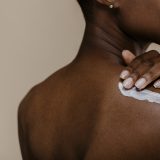Delayed Onset Muscle Soreness

Stupid Exercise
Taking on a new exercise or physical activity can lead to sore aching muscles the next day.
Sometimes the muscle soreness even lingers for a few days making every step, bend, or twist a wince-worthy moment. Fortunately, with conditioning, learning your limits, and a little TLC post-activity, muscle soreness can fade into the past.
Lactic Acid and Sore Muscles
For a long time, the fitness community blamed lactic acid build-up for post-exercise muscle soreness. New studies show that lactic acid does indeed play a role in the muscles during physical exertion. However, it appears to dissipate quite rapidly after the activity stops instead of “building up” in the muscle.
Delayed Onset Muscle Soreness
Currently, the medical community believes that tiny little tears in the muscle fibers, combined perhaps with inflammation, cause the pain. They call it Delayed Onset Muscle Soreness (“DOMS”). In general terms, as long as it feels good when stretched, it isn’t too severe. People often also qualify it as “good pain.”
Steps to prevent DOMS
Working with a personal trainer or exercise specialist when undertaking a new program can help people recognize and understand their limits and how to gradually improve. In general terms, starting slow with a moderate increase from previous activity can work. Then one can gradually increase the intensity. People can also apply this to non-exercise tasks such as gardening, home projects, or cleaning. Jumping in and overdoing it can lead to unwelcome muscle soreness. Take it easy and build up. In either case, warming up can minimize soreness.
Sports Massage
For those who push their limits in training, massage can help. Some people use sports massage directly after training to decrease inflammation and stave off DOMS. One recent (small) study has shown an actual physiological decrease in inflammation in muscles post-exercise with the application of massage. Typically, this type of sports massage entails light to moderate pressure vigorous massage.
Between heavy training cycles, one may use firmer more targeted massage to address problem areas with knots and tension. In either context, adding stretching can help. For people who want to address flexibility as part of their training, a Thai Yoga Massage would be a good addition.
The same principles would apply for someone who had sore muscles from non-exercise activity. In either case, the client would want to share how long it has been since their last intense activity, their typical activity, and what level of muscle soreness they feel. All of these pieces of information help a massage therapist plan a session that will ease the client’s pain.
Self-Care
Some things to try at home for easing DOMS include applying heat or cold, wearing compression garments, and self-massage. Applying heat, especially moist heat, can ease pain. Many people find an Epsom salt bath or heat therapy pillow helpful. Some people prefer cold therapy such as icing or applying a salve such as BioFreeze. Many people find benefit from using compression wear around their taxed muscles. Self-massage techniques like rubbing, kneading, thumping, and jostling the muscle can help get them back in shape as well. Hands or tools such as a massage ball or foam roller can also help speed recovery.
People of all levels of activity and fitness can experience Delayed Onset Muscle Soreness. Taking these steps can help relieve and/or prevent it for free, happy, easy movement.


